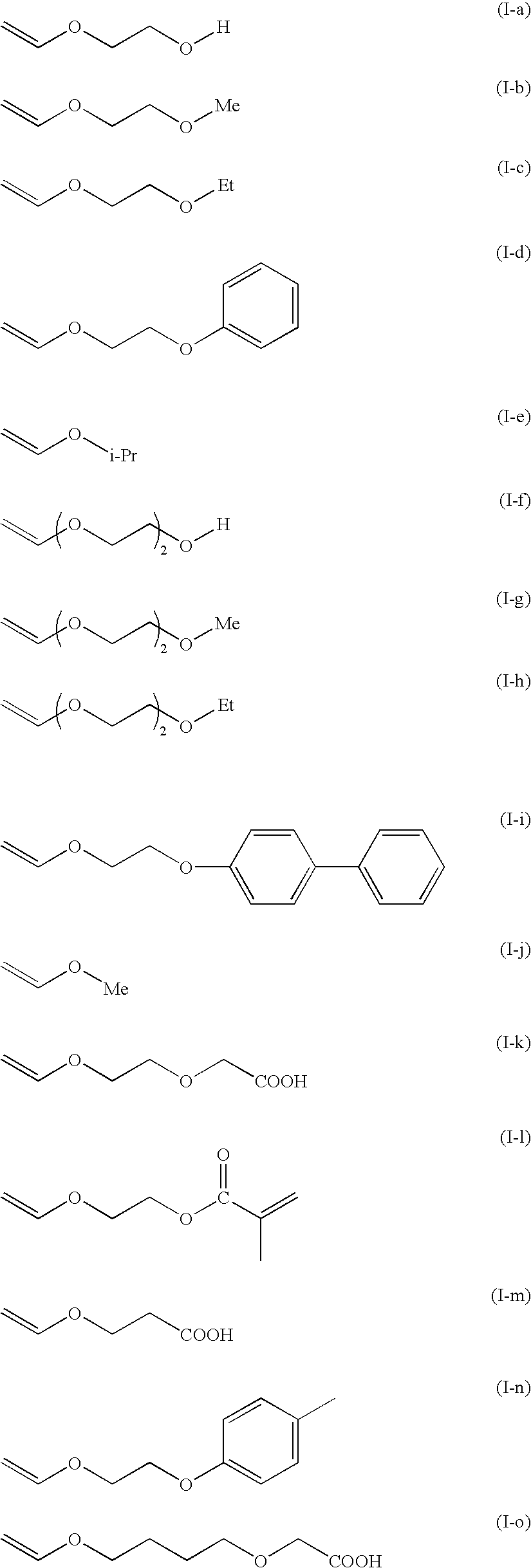Ink composition, ink for inkjet recording, ink set for inkjet recording, inkjet recording apparatus and inkjet recording method
a technology of inkjet recording and composition, which is applied in the direction of inks, instruments, printing, etc., can solve the problems that the fixing process described in these processes is not satisfactory in terms of high-speed fixing characteristics, and achieves excellent high-speed fixing characteristics, excellent wear resistance, water resistance and marker resistance. good ejection stability in the nozzl
- Summary
- Abstract
- Description
- Claims
- Application Information
AI Technical Summary
Benefits of technology
Problems solved by technology
Method used
Image
Examples
manufacturing example 1
[0067]A triblock copolymer (hereinafter referred to as a resin T) of an A-B-C type constituted of blocks A, B, and C was synthesized. The blocks A, B, and C have the following repeating units, respectively.
A:1-isobutoxyethyl vinyl ether(molecular weight: 144.21)B:2-methoxyethyl vinyl ether(molecular weight: 102.13)C:4-(2-vinyl oxyethoxy) benzoate(molecular weight: 196.19)
[0068]The atmosphere inside a glass vessel provided with a three-way tap was substituted with nitrogen, and then heated to 250° C. in the nitrogen gas atmosphere, thereby removing adsorbed water. After returning the system to room temperature, 1-isobutoxyethyl vinyl ether of 12 millimoles, ethyl acetate of 16 millimoles, 1-isobutoxy ethyl acetate of 0.1 millimoles and toluene of 11 milliliters were mixed together in the glass vessel, and when the system temperature reached 0° C., ethylaluminum sesquichloride of 0.2 millimoles was mixed to start polymerization, thereby synthesizing the block A constituting the triblo...
manufacturing example 2
[0071]Using a similar method to the manufacturing example 1, it was possible to manufacture a material having similar molecular weight and similar molecular weight distribution, by cooling the system to −78° C. and then mixing tin (IV) chloride of 0.25 millimoles and 50 millimoles of ethyl chloroacetate, in addition to ethylaluminum sesquichloride of 0.2 millimoles.
[0072]In order to adjust the content of tin in the resin thus obtained, the samples of the resins were rinsed with 0.6 N aqueous hydrochloric acid, thereby refining the resins in such a manner that the mol ratio of the resin to tin in the samples assumed the values shown in Table 1, thus obtaining tin-containing resins having mutually different tin contents.
[0073]Resins containing compounds of metals other than tin were also prepared by adding iron (II) nitrate and zinc chloride, respectively, after manufacturing the polymers.
TABLE 1Mol ratio(resin / PolyvalentAtomicpolyvalentmetalweightValencemetal)Comparative example 1alu...
examples 1 to 6
Practical Examples 1 to 6 and Comparative Examples 1 to 4
[0074]The aqueous inks in the practical examples 1 to 3 of the present invention and the comparative examples 1 to 4 were prepared as follows. 5% of the resin T with the polyvalent metal prepared as described above, 5% of C.I. Solvent Yellow 1 as a coloring material, 10% of glycerine, 10% of diethylene glycol and 1.5% of Olfine E1010 (manufactured by Nissin Chemical Industry) were mixed together and then agitated for ten minutes, then water was added in order to finally achieve a 5% solid content of the coloring material in the aqueous ink, and the mixture was then agitated for one hour. The aqueous ink obtained through this process was filtered by using a membrane filter having a mesh size of 5 μm.
[0075]The ink in a practical example 4 was prepared similarly to the practical example 2, with the exception that the coloring material was changed from C.I. Solvent Yellow 1 to C.I. Solvent Red 27.
[0076]The ink in a practical examp...
PUM
| Property | Measurement | Unit |
|---|---|---|
| Ratio | aaaaa | aaaaa |
| Hydrophilicity | aaaaa | aaaaa |
| Atomic weight | aaaaa | aaaaa |
Abstract
Description
Claims
Application Information
 Login to View More
Login to View More - R&D
- Intellectual Property
- Life Sciences
- Materials
- Tech Scout
- Unparalleled Data Quality
- Higher Quality Content
- 60% Fewer Hallucinations
Browse by: Latest US Patents, China's latest patents, Technical Efficacy Thesaurus, Application Domain, Technology Topic, Popular Technical Reports.
© 2025 PatSnap. All rights reserved.Legal|Privacy policy|Modern Slavery Act Transparency Statement|Sitemap|About US| Contact US: help@patsnap.com


